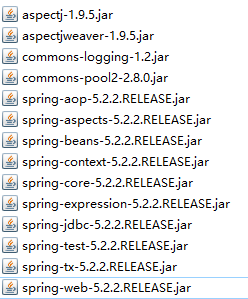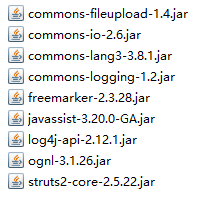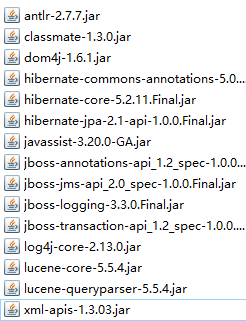SSH integration: Spring 5.2.2 + struts 2.5.22 + Hibernate 5.8
1, Environment construction
Database: MySQL 8
JDK: 13
jar package
-
Spring

-
Struts

-
Hibernate

-
Spring integrates Hibernate

-
Struts integrates Spring

-
-C3p0

-
Connect to database

-
Using Hibernate above JDK8 requires importing

2, Spring integrates Hibernate with case writing of hibernate.cfg.xml
1. Create tables, create mapping classes, and configure mapping class profiles
<?xml version="1.0" encoding="utf-8"?> <!DOCTYPE hibernate-mapping PUBLIC "-//Hibernate/Hibernate Mapping DTD 3.0//EN" "http://www.hibernate.org/dtd/hibernate-mapping-3.0.dtd"> <hibernate-mapping> <!--When the table name and class name are the same, table It can be omitted when the property name and field name are the same column It can be omitted.--> <class name="Full class name with package of mapping class" table="The name of the table in the database corresponding to the class"> <id name="id" column="Field name"> <generator class="native"></generator> </id> <property name="General attribute" column="Field name"></property> </class> </hibernate-mapping>
2. dao level
public class UserDaoImpl implements UserDao { //Using the HibernateTemplate template private HibernateTemplate hibernateTemplate; public void setHibernateTemplate(HibernateTemplate hibernateTemplate) { this.hibernateTemplate = hibernateTemplate; } @Override public void save(User user) { this.hibernateTemplate.save(user); } }
3.Service level
public class UserServiceImpl implements UserService { private UserDao userDao; public void setUserDao(UserDao userDao) { this.userDao = userDao; } @Override public void save(User user) { userDao.save(user); } }
4.Hibernate configuration file hibernate.cfg.xml
<?xml version="1.0" encoding="utf-8"?> <!DOCTYPE hibernate-configuration PUBLIC "-//Hibernate/Hibernate Configuration DTD 3.0//EN" "http://www.hibernate.org/dtd/hibernate-configuration-3.0.dtd"> <hibernate-configuration> <session-factory> <!--Configure database dialect--> <property name="hibernate.dialect">org.hibernate.dialect.MySQLDialect</property> <!--Configuration printing SQL Sentence--> <property name="hibernate.show_sql">true</property> <property name="hibernate.format_sql">true</property> <!--Load the configuration file for the mapping class--> <mapping resource="spring_hibernate/User.hbm.xml"></mapping> </session-factory> </hibernate-configuration>
5.Spring configuration file applicationContext.xml
<?xml version="1.0" encoding="utf-8"?> <beans xmlns="http://www.springframework.org/schema/beans" xmlns:xsi="http://www.w3.org/2001/XMLSchema-instance" xmlns:tx="http://www.springframework.org/schema/tx" xmlns:aop="http://www.springframework.org/schema/aop" xsi:schemaLocation="http://www.springframework.org/schema/beans http://www.springframework.org/schema/beans/spring-beans.xsd http://www.springframework.org/schema/tx http://www.springframework.org/schema/tx/spring-tx.xsd http://www.springframework.org/schema/aop http://www.springframework.org/schema/aop/spring-aop.xsd"> <!--To configure C3P0 Database connection pool--> <bean id="dataSource" class="com.mchange.v2.c3p0.ComboPooledDataSource"> <property name="driverClass" value="com.mysql.cj.jdbc.Driver"></property> <property name="jdbcUrl" value="jdbc:mysql://localhost:3306/demo?useSSL=false&serverTimezone=UTC"></property> <property name="user" value="root"></property> <property name="password" value="123"></property> </bean> <!--HibernateTemplate Bottom use Hibernate Session,Hibernate Session From SessionFactory From, //SessionFactory is the configuration file that the database has obtained from hibernate.cfg.xml -- > <bean id="sessionFactory" class="org.springframework.orm.hibernate5.LocalSessionFactoryBean"> <property name="dataSource" ref="dataSource"></property> <property name="configLocation" value="classpath:spring_hibernate/hibernate.cfg.xml"></property> </bean> <bean id="hibernateTemplate" class="org.springframework.orm.hibernate5.HibernateTemplate"> <property name="sessionFactory" ref="sessionFactory"></property> </bean> <!--To configure UserDaoImpl Of bean--> <bean id="userDao" class="spring_hibernate.dao.impl.UserDaoImpl"> <property name="hibernateTemplate" ref="hibernateTemplate"></property> </bean> <!--To configure UserDaoService Of bean--> <bean id="userService" class="spring_hibernate.service.impl.UserServiceImpl"> <property name="userDao" ref="userDao"></property> </bean> <!--Configure transaction manager HibernateTransactionManager--> <bean id="txManager" class="org.springframework.orm.hibernate5.HibernateTransactionManager"> <!--Transaction manager needs transaction, transaction gets from connection--> <property name="sessionFactory" ref="sessionFactory"></property> </bean> <!--Configure transaction notification, transaction manager is required for transaction notification--> <tx:advice id="txAdvice" transaction-manager="txManager"> <!--Configure transaction notification details--> <tx:attributes> <tx:method name="save"/> </tx:attributes> </tx:advice> <!--Configuration entry point--> <aop:config> <aop:advisor advice-ref="txAdvice" pointcut="execution(* spring_hibernate.service..*.*(..))"></aop:advisor> </aop:config> </beans>
6. test class
//Spring integrates JUnit @RunWith(SpringJUnit4ClassRunner.class) //Load applicationContext.xml @ContextConfiguration(locations = "classpath:spring_hibernate/applicationContext.xml") public class testApp { @Autowired private UserService userService; @Test public void test(){ User user = new User(); user.setUsername("Jack"); user.setPassword("123"); user.setAge(12); userService.save(user); } }
3, Spring integrates Hibernate without hibernate.cfg.xml and the case writing of dao layer inheriting HibernateDaoSupport
1. Modify dao layer
public class UserDaoImpl extends HibernateDaoSupport implements UserDao { @Override public void save(User user) { //Get HibernateTemplate from the parent class HibernateDaoSupport this.getHibernateTemplate().save(user); } }
2. Delete hibernate.cfg.xml and configure some configuration of hibernate to applicationContext.xml
<?xml version="1.0" encoding="utf-8"?> <beans xmlns="http://www.springframework.org/schema/beans" xmlns:xsi="http://www.w3.org/2001/XMLSchema-instance" xmlns:tx="http://www.springframework.org/schema/tx" xmlns:aop="http://www.springframework.org/schema/aop" xsi:schemaLocation="http://www.springframework.org/schema/beans http://www.springframework.org/schema/beans/spring-beans.xsd http://www.springframework.org/schema/tx http://www.springframework.org/schema/tx/spring-tx.xsd http://www.springframework.org/schema/aop http://www.springframework.org/schema/aop/spring-aop.xsd"> <!--To configure c3p0 Database connection pool--> <bean id="dataSource" class="com.mchange.v2.c3p0.ComboPooledDataSource"> <property name="driverClass" value="com.mysql.cj.jdbc.Driver"></property> <property name="jdbcUrl" value="jdbc:mysql://localhost:3306/demo?useSSL=false&serverTimezone=UTC"></property> <property name="user" value="root"></property> <property name="password" value="123"></property> </bean> <!--sessionFactory Used to create Hibernate Session object--> <bean id="sessionFactory" class="org.springframework.orm.hibernate5.LocalSessionFactoryBean"> <!--Database connection required--> <property name="dataSource" ref="dataSource"></property> <!--Configuration in the past hibernate.cfg.xml Some other properties in--> <property name="hibernateProperties"> <props> <prop key="hibernate.dialect">org.hibernate.dialect.MySQLDialect</prop> <prop key="hibernate.show_sql">true</prop> <prop key="hibernate.format_sql">true</prop> </props> </property> <!--The location of the configuration mapping class profile, mappingLocation Wildcards are supported*--> <property name="mappingLocations" value="classpath:spring_hibernate/*/User.hbm.xml"></property> </bean> <!--To configure UserDaoImpl Of bean--> <!--because UserDaoImpl Inherited HibernateDaoSupport,Bottom needs sessionFactory--> <bean id="userDao" class="spring_hibernate.dao.impl.UserDaoImpl"> <property name="sessionFactory" ref="sessionFactory"></property> </bean> <!--To configure UserDaoService Of bean--> <bean id="userService" class="spring_hibernate.service.impl.UserServiceImpl"> <property name="userDao" ref="userDao"></property> </bean> <!--Configure transaction manager HibernateTransactionManager--> <bean id="txManager" class="org.springframework.orm.hibernate5.HibernateTransactionManager"> <!--Transaction manager needs transaction, transaction gets from connection--> <!--<property name="dataSource" ref="dataSource"></property>--> <property name="sessionFactory" ref="sessionFactory"></property> </bean> <!--Configure transaction notification, transaction manager is required for transaction notification--> <tx:advice id="txAdvice" transaction-manager="txManager"> <!--Configure transaction notification details--> <tx:attributes> <tx:method name="save"/> </tx:attributes> </tx:advice> <!--Configuration entry point--> <aop:config> <aop:advisor advice-ref="txAdvice" pointcut="execution(* spring_hibernate.service..*.*(..))"></aop:advisor> </aop:config> </beans>
4, Struts integrates Spring
1. Create Action
public class UserAction extends ActionSupport implements ModelDriven<User> { //Model driven encapsulation data User user = new User(); @Override public User getModel() { return user; } //Spring dynamic injection userService private UserService userService; public void setUserService(UserService userService) { this.userService = userService; } public String save(){ userService.save(user); return "success"; } }
2. Configure Action bean in applicationContext
<bean id="userAction" class="spring_hibernate.action.UserAction"> <property name="userService" ref="userService"></property> </bean>
3. Configure struts.xml
<?xml version="1.0" encoding="utf-8"?> <!DOCTYPE struts PUBLIC "-//Apache Software Foundation//DTD Struts Configuration 2.5//EN" "http://struts.apache.org/dtds/struts-2.5.dtd"> <struts> <!--<constant name="struts.enable.DynamicMethodInvocation" value="true"></constant>--> <package name="default" namespace="/" extends="struts-default"> <!--struts2.5 Using wildcard access action This property must be configured--> <global-allowed-methods>regex:.*</global-allowed-methods> <!--Because in applicationContext.xml Middle configuration Action Of bean therefore class Just direct reference--> <action name="userAction_*" class="userAction" method="{1}"> <result>/success.jsp</result> </action> </package> </struts>
Note: if the id of userservice in applicationContext.xml has the same name as the attribute of userservice in action, step 2 can be omitted. Change the class of action in step 3 to the fully qualified class name

 So modify struts.xml
So modify struts.xml
4. Write index.jsp
<form action="${pageContext.request.contextPath}/userAction_save.action" method="post">
Name: < input type = "text" name = "username" / >
Password: < input type = "password" name = "password" / >
Age: < input type = "text" name = "age" / >
< input type = "submit" value = "submit" / >
</form>

